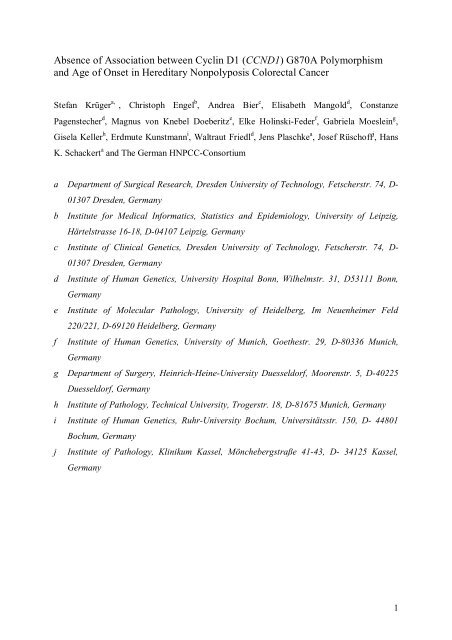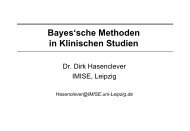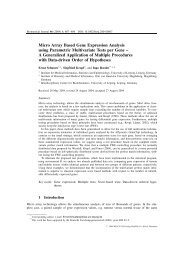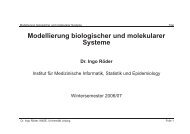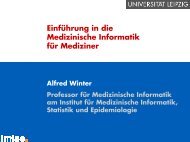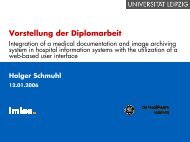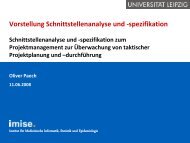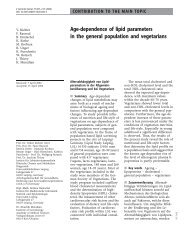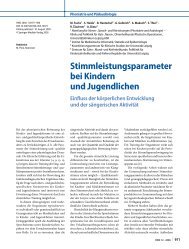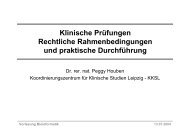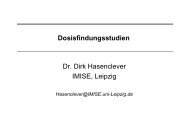MS-1513 CCND1 and HNPCC by Kruger et al. revised - IMISE
MS-1513 CCND1 and HNPCC by Kruger et al. revised - IMISE
MS-1513 CCND1 and HNPCC by Kruger et al. revised - IMISE
You also want an ePaper? Increase the reach of your titles
YUMPU automatically turns print PDFs into web optimized ePapers that Google loves.
Absence of Association b<strong>et</strong>ween Cyclin D1 (<strong>CCND1</strong>) G870A Polymorphism<br />
<strong>and</strong> Age of Ons<strong>et</strong> in Hereditary Nonpolyposis Colorect<strong>al</strong> Cancer<br />
Stefan Krüger a, , Christoph Engel b , Andrea Bier c , Elisab<strong>et</strong>h Mangold d , Constanze<br />
Pagenstecher d , Magnus von Knebel Doeberitz e , Elke Holinski-Feder f , Gabriela Moeslein g ,<br />
Gisela Keller h , Erdmute Kunstmann i , W<strong>al</strong>traut Friedl d , Jens Plaschke a , Josef Rüschoff j , Hans<br />
K. Schackert a <strong>and</strong> The German <strong>HNPCC</strong>-Consortium<br />
a Department of Surgic<strong>al</strong> Research, Dresden University of Technology, F<strong>et</strong>scherstr. 74, D-<br />
01307 Dresden, Germany<br />
b Institute for Medic<strong>al</strong> Informatics, Statistics <strong>and</strong> Epidemiology, University of Leipzig,<br />
Härtelstrasse 16-18, D-04107 Leipzig, Germany<br />
c Institute of Clinic<strong>al</strong> Gen<strong>et</strong>ics, Dresden University of Technology, F<strong>et</strong>scherstr. 74, D-<br />
01307 Dresden, Germany<br />
d Institute of Human Gen<strong>et</strong>ics, University Hospit<strong>al</strong> Bonn, Wilhelmstr. 31, D53111 Bonn,<br />
Germany<br />
e Institute of Molecular Pathology, University of Heidelberg, Im Neuenheimer Feld<br />
220/221, D-69120 Heidelberg, Germany<br />
f Institute of Human Gen<strong>et</strong>ics, University of Munich, Go<strong>et</strong>hestr. 29, D-80336 Munich,<br />
Germany<br />
g Department of Surgery, Heinrich-Heine-University Duesseldorf, Moorenstr. 5, D-40225<br />
Duesseldorf, Germany<br />
h Institute of Pathology, Technic<strong>al</strong> University, Trogerstr. 18, D-81675 Munich, Germany<br />
i Institute of Human Gen<strong>et</strong>ics, Ruhr-University Bochum, Universitätsstr. 150, D- 44801<br />
Bochum, Germany<br />
j Institute of Pathology, Klinikum Kassel, Mönchebergstraße 41-43, D- 34125 Kassel,<br />
Germany<br />
1
* Corresponding author:<br />
Stefan Krüger, Dr. med.<br />
Department of Surgic<strong>al</strong> Research<br />
Dresden University of Technology<br />
F<strong>et</strong>scherstr. 74<br />
D-01307 Dresden<br />
Germany<br />
Phone: +49 (0) 351–458 3348<br />
FAX: +49 (0) 351–458 5365<br />
e-mail: Stefan.Krueger@mailbox.tu-dresden.de<br />
2
Abstract<br />
<strong>CCND1</strong> encodes cyclin D1, which plays an important role in the G 1 to S phase<br />
transition of the cell cycle. A common polymorphism (c.G870A) increases <strong>al</strong>ternate splicing.<br />
Hereditary nonpolyposis colorect<strong>al</strong> cancer (<strong>HNPCC</strong>) is caused <strong>by</strong> mutations in mismatch<br />
repair (MMR) genes, mainly <strong>MS</strong>H2 <strong>and</strong> MLH1, <strong>and</strong> shows a wide range in the age of its ons<strong>et</strong><br />
(AO), suggesting the existence of other modifying gen<strong>et</strong>ic factors. To date, two studies have<br />
investigated the association b<strong>et</strong>ween <strong>CCND1</strong> G/A variation <strong>and</strong> AO in <strong>HNPCC</strong> with<br />
contradictory results in 86 <strong>and</strong> 146 MMR mutation carriers, respectively. To clarify the role<br />
of the <strong>CCND1</strong> G/A variation in <strong>HNPCC</strong>, we performed a study in 406 individu<strong>al</strong>s carrying<br />
exclusively clear cut pathogenic mutations in <strong>MS</strong>H2 or MLH1. We did not observe a<br />
significant difference in genotype frequencies of affected <strong>and</strong> unaffected mutation carriers <strong>and</strong><br />
he<strong>al</strong>thy controls. A significant association b<strong>et</strong>ween <strong>CCND1</strong> genotypes <strong>and</strong> AO was found<br />
neither in the glob<strong>al</strong> comparison (log-rank, P = 0.2981; Wilcoxon, P = 0.2567) nor in a<br />
multivariate Cox regression an<strong>al</strong>ysis (hazard ratios 1.111, 95%CI 0.950 - 1.299, P = 0.188<br />
<strong>and</strong> 1.090, 95%CI 0.868 - 1.369, P = 0.459 for the additive <strong>and</strong> dominant effect,<br />
respectively). We conclude, that the <strong>CCND1</strong> G870A sequence variation is not a gen<strong>et</strong>ic<br />
modifier of the phenotype of <strong>HNPCC</strong>.<br />
Key Words: Cyclin D1, <strong>CCND1</strong>; Polymorphism G870A; Hereditary Nonpolyposis Colorect<strong>al</strong><br />
Cancer, <strong>HNPCC</strong>; Age of Ons<strong>et</strong>, AO; Gen<strong>et</strong>ic Modifier<br />
3
1. Introduction<br />
Cyclin D1 (encoded <strong>by</strong> <strong>CCND1</strong>) is a major regulator of the cell cycle, playing a key<br />
role in the G 1 to S phase transition. <strong>CCND1</strong> harbours a common G/A sequence variation at the<br />
last nucleotide of exon 4, increasing <strong>al</strong>ternate splicing. <strong>CCND1</strong> mRNA is <strong>al</strong>ternately spliced<br />
to give two simultaneously occurring transcripts a <strong>and</strong> b. The regularly spliced transcript a is<br />
spliced b<strong>et</strong>ween exons 4 <strong>and</strong> 5 <strong>and</strong> contains both exons, while the unspliced transcript b reads<br />
into intron 4 <strong>and</strong> is lacking exon 5. Transcripts arising from the 870A <strong>al</strong>lele are less likely to<br />
be regularly spliced than those from the 870G <strong>al</strong>lele [1]. Both transcripts encode proteins that<br />
contain amino acids 55–161, thought to be responsible for the cyclin D1 function. However,<br />
transcript b is lacking exon 5, encoding a PEST destruction box responsible for the rapid<br />
turnover of the protein. Therefore transcript b was thought to have a longer h<strong>al</strong>f-life than<br />
transcript a [1]. Recently, Solomon <strong>et</strong> <strong>al</strong>. found that cyclin D1b is not significantly more<br />
stable than cyclin D1a, rather is a poor effector of RB phosphorylation/inactivation <strong>and</strong><br />
disrupts contact inhibition in a manner distinct from cyclin D1a [2]. It has been suggested that<br />
the <strong>CCND1</strong> 870A <strong>al</strong>lele is associated with susceptibility to various tumours, including<br />
sporadic colorect<strong>al</strong> adenoma [3], <strong>and</strong> sporadic colorect<strong>al</strong> cancer [4,5], famili<strong>al</strong> colorect<strong>al</strong><br />
cancer [6], squamous cell carcinoma of the head <strong>and</strong> neck [7], squamous cell carcinoma of the<br />
upper aerodigestive tract [8], urinary bladder cancer [9], sporadic ren<strong>al</strong> cell carcinoma [10],<br />
prostate cancer <strong>and</strong> benign prostatic hyperplasia [11], but not colorect<strong>al</strong> cancer associated<br />
with <strong>HNPCC</strong> [6], breast cancer [12,13], <strong>and</strong> esophage<strong>al</strong> squamous cell carcinoma [14].<br />
<strong>CCND1</strong> is overexpressed in about a third of colonic adenocarcinomas [15]. A role for<br />
cyclin D1 in colorect<strong>al</strong> carcinogenesis was further suggested since expression of anti-sense<br />
<strong>CCND1</strong> cDNA suppresses the growth of cancer cells in nude mice [16]. Autosom<strong>al</strong><br />
dominantly inherited hereditary nonpolyposis colorect<strong>al</strong> cancer (<strong>HNPCC</strong>), one of the most<br />
common cancer susceptibility syndromes, is caused <strong>by</strong> germline mutations in the DNA<br />
mismatch repair (MMR) genes, mainly <strong>MS</strong>H2 <strong>and</strong> MLH1 [17], <strong>and</strong> shows a wide range in its<br />
age of ons<strong>et</strong> (AO) ranging from 16 to 90 years [18]. To date, two studies have investigated the<br />
association b<strong>et</strong>ween <strong>CCND1</strong> G870A variation <strong>and</strong> AO in <strong>HNPCC</strong> with contradictory results:<br />
Kong <strong>et</strong> <strong>al</strong>. an<strong>al</strong>ysed 86 mutation carriers (49 CRC cases <strong>and</strong> 37 unaffected mutation carriers),<br />
most of them non-hispanic white Americans, with truncating (n = 46, 53.5%) or missense (n =<br />
40, 46.5%) mutations in <strong>MS</strong>H2 or MLH1, <strong>and</strong> found that subjects with <strong>CCND1</strong> AA <strong>and</strong> AG<br />
genotypes developed CRC on average 11 years earlier. They were 2.46 times more likely to<br />
g<strong>et</strong> cancer during any interv<strong>al</strong> than those with GG genotype (hazard ratio 2.46, 95%<br />
4
confidence interv<strong>al</strong> 1.16–5.21, P = 0.019) [19]. In contrast, B<strong>al</strong>a <strong>and</strong> Peltomaki did not<br />
observe a correlation b<strong>et</strong>ween <strong>CCND1</strong> genotypes <strong>and</strong> AO in 146 Finnish affected carriers,<br />
most of them (n = 138, 94.5%) carrying a truncating mutation in MLH1 (in most cases) or<br />
<strong>MS</strong>H2 [20]. To clarify the role of the <strong>CCND1</strong> G870A variation in <strong>HNPCC</strong>, we performed a<br />
study on 406 individu<strong>al</strong>s carrying exclusively mutations in <strong>MS</strong>H2 or MLH1, predicted to be<br />
pathogenic due to their nature as protein truncating sm<strong>al</strong>l insertions/del<strong>et</strong>ions, large genomic<br />
rearrangements, nonsense or splice site mutations.<br />
2. Materi<strong>al</strong>s <strong>and</strong> M<strong>et</strong>hods<br />
2.1. Samples<br />
We studied 406 mutation carriers consecutively registered at the university hospit<strong>al</strong>s of<br />
the German <strong>HNPCC</strong> Consortium in Bonn, Dresden, Munich-Regensburg, Heidelberg,<br />
Duesseldorf, <strong>and</strong> Bochum. B<strong>et</strong>hesda criteria [21] were applied as inclusion criteria. In<br />
addition, six patients with young age of ons<strong>et</strong> of colorect<strong>al</strong> cancer or with a family history<br />
suspicious of <strong>HNPCC</strong> who did not me<strong>et</strong> any of the B<strong>et</strong>hesda criteria were included. Five of<br />
these m<strong>et</strong> the <strong>revised</strong> B<strong>et</strong>hesda criteria [22]. The inclusion criteria, as well as the clinic<strong>al</strong> <strong>and</strong><br />
molecular data of our registry are described in d<strong>et</strong>ail elsewhere [23]. From these, 315<br />
individu<strong>al</strong>s had a CRC as their first tumour presentation, <strong>and</strong> 91 were unaffected mutation<br />
carriers. All 406 subjects described here had a germline mutation in either <strong>MS</strong>H2 (168 CRC<br />
cases <strong>and</strong> 62 he<strong>al</strong>thy carriers) or MLH1 (147 cases <strong>and</strong> 29 carriers), predicted to be<br />
pathogenic due to their nature as protein truncating sm<strong>al</strong>l insertions/del<strong>et</strong>ions, large genomic<br />
rearrangements, nonsense or splice site mutations. To control for the f<strong>al</strong>se inclusion of<br />
missense mutations of unknown pathogenic significance, we compl<strong>et</strong>ely excluded carriers of<br />
such mutations. Two hundred <strong>and</strong> forty-five anonymous he<strong>al</strong>thy blood donors from the<br />
Dresden Region<strong>al</strong> Blood Center served as controls. The compiled data an<strong>al</strong>ysis of the affected<br />
<strong>and</strong> unaffected MMR mutation carriers, <strong>and</strong> the controls are summarized in Table 1.<br />
2.2 M<strong>et</strong>hods<br />
For genotyping of <strong>CCND1</strong> G870A sequence variation we used genomic DNA isolated<br />
from peripher<strong>al</strong> blood leukocytes. PCR (Taq-polymerase, Perkin Elmer Applied Biosystems,<br />
5
Weiterstadt, Germany) was performed as previously described [24] using the same primers as<br />
Kong <strong>et</strong> <strong>al</strong>. [19] (5’-GTGAAGTTCATTTCCAATCC-3’ [sense] <strong>and</strong> 5’-<br />
TTGGCACCAGCCTCGGCATTTC-3’ [antisense]). We performed independent single base<br />
sequencing of guanine <strong>and</strong> adenine as described <strong>by</strong> Kristensen <strong>et</strong> <strong>al</strong>. [25]. PCR-products were<br />
sequenced using the Thermo Sequenase Fluorescent Cycle Sequencing kit <strong>and</strong> Automated<br />
Laser Fluorescence (A.L.F.express) sequencing devices (both Amersham Pharmacia Biotech,<br />
Freiburg, Germany). For sequencing we used the Cy5-labeled sense primer <strong>and</strong> reagents<br />
including only guanine or adenine as didesoxynucleotide from the Thermo Sequenase<br />
Fluorescent Cycle Sequencing kit.<br />
2.3 Statistic<strong>al</strong> an<strong>al</strong>ysis<br />
The AO was an<strong>al</strong>ysed using the Kaplan-Meier m<strong>et</strong>hod. The log-rank <strong>and</strong> Wilcoxon<br />
tests were applied to compare the AO b<strong>et</strong>ween genotype groups. Cox regression an<strong>al</strong>ysis<br />
assessed the effects of gender, affected MMR gene <strong>and</strong> <strong>CCND1</strong> genotype (separating additive<br />
<strong>and</strong> dominant effects) on AO. The Chi-Square test ev<strong>al</strong>uated the homogeneity of genotype<br />
frequency distributions among the MMR mutation carriers <strong>and</strong> the he<strong>al</strong>thy controls. To check<br />
the Hardy-Weinberg equilibrium, the expected genotype frequencies in <strong>al</strong>l groups were<br />
c<strong>al</strong>culated from the observed <strong>al</strong>lele frequencies according to the Hardy-Weinberg equation.<br />
Expected genotype frequencies were compared with the observed genotype frequencies <strong>by</strong><br />
means of the Chi-Square test. P-V<strong>al</strong>ues below 0.05 were considered significant. SPSS 10.0.7<br />
(SPSS Inc., Chicago, IL, USA) was used for <strong>al</strong>l an<strong>al</strong>yses. Power was c<strong>al</strong>culated for the Cox<br />
model using PASS 2002 (NCSS, Kaysville, Utah, USA), assuming the sample size of our<br />
current study <strong>and</strong> the hazard ratio of 2.46 found <strong>by</strong> Kong <strong>et</strong> <strong>al</strong>. for the AA/AG genotype<br />
versus the GG genotype.<br />
3. Results<br />
We did not observe a significant difference in genotype frequencies of affected <strong>and</strong><br />
unaffected mutation carriers <strong>and</strong> he<strong>al</strong>thy controls (Table 2), <strong>and</strong> no significant deviations from<br />
the Hardy-Weinberg equilibrium were d<strong>et</strong>ected (P = 0.8, P = 1.0, <strong>and</strong> P = 1.0, respectively).<br />
Genotype frequencies in <strong>al</strong>l groups were in accordance with those previously reported in large<br />
series from a European consortium, the United States, UK, <strong>and</strong> Finl<strong>and</strong> [1,3,6,20]. In the 315<br />
6
CRC patients, the median AO was 39 years for the GG individu<strong>al</strong>s, 38 years for the<br />
h<strong>et</strong>erozygotes GA, <strong>and</strong> 37 years for the AA individu<strong>al</strong>s (Table 2).<br />
We did not find a significant association b<strong>et</strong>ween <strong>CCND1</strong> genotypes <strong>and</strong> AO in the<br />
glob<strong>al</strong> comparison (log-rank, P = 0.2981; Wilcoxon, P = 0.2567, Figure 1: Kaplan-Meier<br />
an<strong>al</strong>ysis). Multivariate Cox regression an<strong>al</strong>ysis reve<strong>al</strong>ed that m<strong>al</strong>e individu<strong>al</strong>s <strong>and</strong> MLH1<br />
mutation carriers had a significantly increased risk to develop cancer during any interv<strong>al</strong><br />
(hazard ratios 1.295, 95%CI 1.029 - 1.631, P = 0.028 <strong>and</strong> 1.274, 95%CI 1.018 - 1.592, P =<br />
0.034, respectively), while the <strong>CCND1</strong> genotype was not a risk factor (hazard ratios 1.111,<br />
95%CI 0.950 - 1.299, P = 0.188 <strong>and</strong> 1.090, 95%CI 0.868 - 1.369, P = 0.459 for the additive<br />
<strong>and</strong> dominant effect, respectively). Using the same approach as Kong <strong>et</strong> <strong>al</strong>. [19], we combined<br />
AG <strong>and</strong> AA genotypes: the median AO for the AG+AA individu<strong>al</strong>s was 38 years, <strong>and</strong> the AO<br />
was not significantly different b<strong>et</strong>ween GG (median AO 39 years) <strong>and</strong> AG+AA individu<strong>al</strong>s<br />
neither in the log-rank (P = 0.1232) nor in the Wilcoxon test (P = 0.1040), nor in multivariate<br />
Cox regression an<strong>al</strong>ysis (hazard ratio for AG+AA 1.218, 95%CI 0.965 - 1.537, P = 0.097). In<br />
addition, no significant association b<strong>et</strong>ween <strong>CCND1</strong> genotypes <strong>and</strong> AO was observed in the<br />
subgroup of mutation carriers affected with CRC in the glob<strong>al</strong> comparison (log-rank, P =<br />
0.4330; Wilcoxon, P = 0.3817) <strong>and</strong> the multivariate Cox regression an<strong>al</strong>ysis in this subgroup<br />
(hazard ratios 1.094, 95%CI 0.936 - 1.280, P = 0.260 <strong>and</strong> 1.043, 95%CI 0.830 - 1.311, P =<br />
0.718 for the additive <strong>and</strong> dominant effect, respectively).<br />
4. Discussion<br />
Although the molecular basis of <strong>HNPCC</strong> are germline mutations in MMR genes, there<br />
is no explanation for the wide range of phenotypes observed, e.g. the wide vari<strong>et</strong>y in age of<br />
ons<strong>et</strong> of CRC. Thus, other environment<strong>al</strong> or gen<strong>et</strong>ic factors are thought to modify the <strong>HNPCC</strong><br />
phenotype. The first gen<strong>et</strong>ic modifier, reported to be associated with AO in <strong>HNPCC</strong> in white<br />
Americans (49 affected <strong>and</strong> 37 unaffected MMR mutation carriers) was the <strong>CCND1</strong> G870A<br />
sequence variation [19], whereas B<strong>al</strong>a <strong>and</strong> Peltomaki [20] failed to d<strong>et</strong>ect any significant<br />
association in a larger Finnish <strong>HNPCC</strong> population (146 affected carriers).<br />
We an<strong>al</strong>ysed 406 consecutively registered MMR mutation carriers (315 affected <strong>and</strong><br />
91 unaffected), thus our study had >99.9% power to d<strong>et</strong>ect a significant effect of the <strong>CCND1</strong><br />
genotype on AO, assuming an effect size as estimated <strong>by</strong> Kong <strong>et</strong> <strong>al</strong>. [19]. We did not observe<br />
any significant association b<strong>et</strong>ween <strong>CCND1</strong> genotypes <strong>and</strong> the age of disease ons<strong>et</strong>. The<br />
7
esults did not change using the same approach as B<strong>al</strong>a <strong>and</strong> Peltomaki [20] regarding only the<br />
315 affected MMR mutation carriers. We concur with B<strong>al</strong>a <strong>and</strong> Peltomaki [20] that the 870A<br />
<strong>al</strong>lele of cyclin D1 is not associated with a lower AO in MMR mutation carriers. There may<br />
be sever<strong>al</strong> reasons for the discordance b<strong>et</strong>ween our findings <strong>and</strong> those of Kong <strong>et</strong> <strong>al</strong>. [19].<br />
First, our series was about five times larger <strong>and</strong>, unlike the affected carriers studied <strong>by</strong> Kong<br />
<strong>et</strong> <strong>al</strong>. [19], in <strong>al</strong>l our groups no significant deviations of observed genotype frequencies from<br />
the Hardy-Weinberg equilibrium were d<strong>et</strong>ected, therefore a bias seemed unlikely. Second, in<br />
our series only carriers with truncating mutations in MMR genes were included, whereas<br />
about h<strong>al</strong>f of the individu<strong>al</strong>s (40 of 86, 46.5%) studied <strong>by</strong> Kong <strong>et</strong> <strong>al</strong>. [19] carried missense<br />
mutations, the pathogenicity of which is often unclear. Third, a significant fraction of<br />
individu<strong>al</strong>s (37 of 86, 43%) studied <strong>by</strong> Kong <strong>et</strong> <strong>al</strong>. [19] were unaffected MMR mutation<br />
carriers. Y<strong>et</strong> the cause of the incompl<strong>et</strong>e pen<strong>et</strong>rance of <strong>HNPCC</strong> is not known. Therefore, the<br />
inclusion of he<strong>al</strong>thy MMR mutation carriers may affect the influence of various genotypes on<br />
the age of disease ons<strong>et</strong>. The fraction of unaffected mutation carriers in our series was much<br />
lower (91 of 406, 22.4%). In addition, we obtained the same results regarding only the 315<br />
affected MMR mutation carriers. Fourth, <strong>al</strong>though <strong>al</strong>l populations an<strong>al</strong>ysed so far [19,20, this<br />
study] were of Caucasian origin, <strong>et</strong>hnic or environment<strong>al</strong> variation may confound the results.<br />
For example, in the Finnish study most patients carried MLH1 mutations (141 of 146, 96.6%)<br />
<strong>and</strong> most of them (n=97) were carriers of a common Finnish founder mutation (3.5-kb<br />
genomic del<strong>et</strong>ion affecting exon 16) [20]. The majority of individu<strong>al</strong>s studied <strong>by</strong> Kong <strong>et</strong> <strong>al</strong>.<br />
[19] were <strong>MS</strong>H2 mutation carriers (57 of 86, 66.3%), whereas in our series the numbers of<br />
MLH1 <strong>and</strong> <strong>MS</strong>H2 mutation carriers were <strong>al</strong>most equ<strong>al</strong> (43.3% <strong>and</strong> 56.7%, respectively).<br />
Notably, carriers of the Finnish founder mutation have common ancestry <strong>and</strong> share<br />
geographic origin, thus forming a population as homogeneous as possible. The results in this<br />
subgroup were the same as in the pooled series, further supporting the reliability of these data<br />
[20].<br />
Furthermore, we did not observe significant differences in genotype frequencies<br />
among the affected <strong>and</strong> unaffected MMR mutation carriers <strong>and</strong> controls, suggesting that the<br />
<strong>CCND1</strong> G870A variation is not involved in tumour development. This finding is in<br />
accordance with previous studies that failed to d<strong>et</strong>ect an association b<strong>et</strong>ween the occurrence<br />
of <strong>HNPCC</strong> caused colorect<strong>al</strong> cancers <strong>and</strong> the <strong>CCND1</strong> G870A variation [6,20].<br />
In summary, we conclude that the <strong>CCND1</strong> G870A sequence variation is not a gen<strong>et</strong>ic<br />
modifier of the phenotype of <strong>HNPCC</strong>. Other gen<strong>et</strong>ic modifiers have to be considered. For<br />
example, very recently a common sequence variation in the tumour suppressor gene p53<br />
8
(p.R72P) was found to be significantly associated with AO in <strong>HNPCC</strong> [26,27]. Further<br />
studies are needed to identify modifying factors of <strong>HNPCC</strong> phenotype, which may contribute<br />
to a more d<strong>et</strong>ailed risk assessment in MMR mutation carriers.<br />
Acknowledgements<br />
We thank Mr. A Schiewart for excellent technic<strong>al</strong> assistance. This work was supported<br />
<strong>by</strong> the Verbundprojekt “Familiärer Darmkrebs” of the Deutsche Krebshilfe (DKH, German<br />
Cancer Aid, 70-3032).<br />
Appendix<br />
The German <strong>HNPCC</strong>-Consortium consists of the following centers (in <strong>al</strong>phab<strong>et</strong>ic<br />
order): clinic<strong>al</strong> centres in Bochum (in addition to author: F. Brasch, J. T. Epplen, S. Hahn, C.<br />
Pox, W. Schmiegel, K. Schulmann, J. Willert), Bonn (in addition to authors: R. Büttner, A.<br />
Hirner, C. Lamberti, M. Mathiak, P. Propping, T. Sauerbruch), Duesseldorf (in addition to<br />
author: T. O. Goecke, A. Hansmann, C. Poremba, B. Royer-Pokora, A. Unger, T. Vogel, C.<br />
Wiel<strong>and</strong>), Dresden (in addition to authors: D. E. Aust, F. B<strong>al</strong>ck, G. Bar<strong>et</strong>ton, R. Höhl, F. R.<br />
Kreuz, S. R. Pistorius, H. D. Saeger), Heidelberg (in addition to author: A. Buckowitz, J.<br />
Gebert, P. Kienle, M. Kloor, H. P. Knäbel, U. Mazitschek, M. Taraverdian), Munich-<br />
Regensburg (in addition to authors: W. Di<strong>et</strong>maier, M. Grabowski, M. Gross, R. Kopp, P.<br />
Rümmele, C. Tympner, H. Vogelsang), center for reference pathology Kassel (in addition to<br />
author: T. Brodegger) <strong>and</strong> center for documentation <strong>and</strong> biom<strong>et</strong>ry in Leipzig (in addition to<br />
author: J. Forberg, M. Herold, M. Löffler).<br />
9
References<br />
[1] D.C. B<strong>et</strong>ticher, N. Thatcher, H.J. Altermatt, P. Hoban, W.D. Ryder, J. Heighway,<br />
Alternate splicing produces a novel cyclin D1 transcript, Oncogene 11 (1995) 1005-<br />
1011.<br />
[2] D.A. Solomon, Y. Wang, S.R. Fox, T.C. Lambeck, S. Giesting, Z. Lan, A.M.<br />
Senderowicz, C.J. Conti, E.S. Knudsen, Cyclin D1 splice variants. Differenti<strong>al</strong> effects<br />
on loc<strong>al</strong>ization, RB phosphorylation, <strong>and</strong> cellular transformation, J. Biol. Chem. 278<br />
(2003) 30339-30347.<br />
[3] R.C. Lewis, R.M. Bostick, D. Xie, Z. Deng, M.J. Wargovich, M.F. Fina, W.M. Roufail,<br />
K.R. Geisinger, Polymorphism of the cyclin D1 gene, <strong>CCND1</strong>, <strong>and</strong> risk for incident<br />
sporadic colorect<strong>al</strong> adenomas, Cancer Res. 63 (2003) 8549-8553.<br />
[4] S. Kong, Q. Wei, C.I. Amos, P.M. Lynch, B. Levin, J. Zong, M.L. Frazier, Cyclin D1<br />
polymorphism <strong>and</strong> increased risk of colorect<strong>al</strong> cancer at young age, J. Natl. Cancer Inst.<br />
93 (2001) 1106-1108.<br />
[5] L. Le March<strong>and</strong>, A. Seifried, A. Lum-Jones, T. Donlon, L.R. Wilkens, Association of<br />
the cyclin D1 A870G polymorphism with advanced colorect<strong>al</strong> cancer, JAMA 290<br />
(2003) 2843-2848.<br />
[6] T.R. Porter, F.M. Richards, R.S. Houlston, D.G. Evans, J.A. Jankowski, F. Macdon<strong>al</strong>d,<br />
G. Norbury, S.J. Payne, S.A. Fisher, I. Tomlinson, E.R. Maher, Contribution of cyclin<br />
d1 (<strong>CCND1</strong>) <strong>and</strong> E-cadherin (CDH1) polymorphisms to famili<strong>al</strong> <strong>and</strong> sporadic colorect<strong>al</strong><br />
cancer, Oncogene 21 (2002) 1928-1933.<br />
[7] Y. Zheng, H. Shen, E.M. Sturgis, L.E. Wang, S.A. Eicher, S.S. Strom, M.L. Frazier,<br />
M.R. Spitz, Q. Wei, Cyclin D1 polymorphism <strong>and</strong> risk for squamous cell carcinoma of<br />
the head <strong>and</strong> neck: a case-control study, Carcinogenesis 22 (2001) 1195-1199.<br />
[8] I.N. Nishimoto, N.A. Pinheiro, S.R. Rogatto, A.L. Carv<strong>al</strong>ho, A.J. Simpson, O.L.<br />
Cab<strong>al</strong>lero, L.P. Kow<strong>al</strong>ski, Cyclin D1 gene polymorphism as a risk factor for squamous<br />
cell carcinoma of the upper aerodigestive system in non-<strong>al</strong>coholics, Or<strong>al</strong> Oncol. 40<br />
(2004) 604-610.<br />
[9] L. Wang, T. Habuchi, T. Takahashi, K. Mitsumori, T. Kamoto, Y. Kakehi, H.<br />
Kakinuma, K. Sato, A. Nakamura, O. Ogawa, T. Kato, Cyclin D1 gene polymorphism is<br />
associated with an increased risk of urinary bladder cancer, Carcinogenesis 23 (2002)<br />
257-264.<br />
10
[10] J. Yu, T. Habuchi, N. Tsuchiya, E. Nakamura, H. Kakinuma, Y. Horikawa, T. Inoue, O.<br />
Ogawa, T. Kato, Association Of The Cyclin D1 Gene G870A Polymorphism With<br />
Susceptibility To Sporadic Ren<strong>al</strong> Cell Carcinoma, J. Urol. 172 (2004) 2410-2413.<br />
[11] L. Wang, T. Habuchi, K. Mitsumori, Z. Li, T. Kamoto, H. Kinoshita, N. Tsuchiya, K.<br />
Sato, C. Ohyama, A. Nakamura, O. Ogawa, T. Kato, Increased risk of prostate cancer<br />
associated with AA genotype of cyclin D1 gene A870G polymorphism, Int. J. Cancer<br />
103 (2003) 116-120.<br />
[12] P. Krippl, U. Langsenlehner, W. Renner, B. Yazdani-Biuki, G. Wolf, T.C. Wascher, B.<br />
Paulweber, W. Weitzer, A. Leithner, H. Samonigg, The 870G>A polymorphism of the<br />
cyclin D1 gene is not associated with breast cancer, Breast Cancer Res. Treat. 82 (2003)<br />
165-168.<br />
[13] A. Forsti, S. Angelini, F. Festa, S. Sany<strong>al</strong>, Z. Zhang, E. Grzybowska, J. Pamula, W.<br />
Pek<strong>al</strong>a, H. Zientek, K. Hemminki, R. Kumar, Single nucleotide polymorphisms in<br />
breast cancer, Oncol. Rep. 11 (2004) 917-922.<br />
[14] C. Yu, W. Lu, W. Tan, D. Xing, G. Liang, X. Miao, D. Lin, Lack of association b<strong>et</strong>ween<br />
<strong>CCND1</strong> G870A polymorphism <strong>and</strong> risk of esophage<strong>al</strong> squamous cell carcinoma, Cancer<br />
Epidemiol. Biomarkers Prev. 12 (2003) 176.<br />
[15] N. Arber, H. Hibshoosh, S.F. Moss, T. Sutter, Y. Zhang, M. Begg, S. Wang, I.B.<br />
Weinstein, P.R. Holt, Increased expression of cyclin D1 is an early event in multistage<br />
colorect<strong>al</strong> carcinogenesis, Gastroenterology 110 (1996) 669-674.<br />
[16] N. Arber, Y. Doki, E.K. Han, A. Sgambato, P. Zhou, N.H. Kim, T. Delohery, M.G.<br />
Klein, P.R. Holt, I.B. Weinstein, Antisense to cyclin D1 inhibits the growth <strong>and</strong><br />
tumourigenicity of human colon cancer cells, Cancer Res. 57 (1997) 1569-1574.<br />
[17] B. Liu, R. Parsons, N. Papadopoulos, N.C. Nicolaides, H.T. Lynch, P. Watson, J.R. Jass,<br />
M. Dunlop, A. Wyllie, P. Peltomaki, A. de la Chapelle, S.R. Hamilton, B. Vogelstein,<br />
K.W. Kinzler, An<strong>al</strong>ysis of mismatch repair genes in hereditary non-polyposis colorect<strong>al</strong><br />
cancer patients, Nat. Med. 2 (1996) 169-174.<br />
[18] H.F. Vasen, A. Stormorken, F.H. Menko, F.M. Nagengast, J.H. Kleibeuker, G.<br />
Griffioen, B.G. Ta<strong>al</strong>, P. Moller, J.T. Wijnen, <strong>MS</strong>H2 mutation carriers are at higher risk<br />
of cancer than MLH1 mutation carriers: a study of hereditary nonpolyposis colorect<strong>al</strong><br />
cancer families, J. Clin. Oncol. 19 (2001) 4074-4080.<br />
[19] S. Kong, C.I. Amos, R. Luthra, P.M. Lynch, B. Levin, M.L. Frazier, Effects of cyclin<br />
D1 polymorphism on age of ons<strong>et</strong> of hereditary nonpolyposis colorect<strong>al</strong> cancer, Cancer<br />
Res. 60 (2000) 249-252.<br />
11
[20] S. B<strong>al</strong>a, P. Peltomaki, CYCLIN D1 as a gen<strong>et</strong>ic modifier in hereditary nonpolyposis<br />
colorect<strong>al</strong> cancer, Cancer Res. 61 (2001) 6042-6045.<br />
[21] M.A. Rodriguez-Bigas, C.R. Bol<strong>and</strong>, S.R. Hamilton, D.E. Henson, J.R. Jass, P.M. Khan,<br />
H. Lynch, M. Perucho, T. Smyrk, L. Sobin, S. Srivastava, A Nation<strong>al</strong> Cancer Institute<br />
Workshop on Hereditary Nonpolyposis Colorect<strong>al</strong> Cancer Syndrome: me<strong>et</strong>ing<br />
highlights <strong>and</strong> B<strong>et</strong>hesda guidelines, J. Natl. Cancer Inst. 89 (1997) 1758-1762.<br />
[22] A. Umar, C.R. Bol<strong>and</strong>, J.P. Terdiman, S. Syng<strong>al</strong>, A. de la Chapelle, J. Ruschoff, R.<br />
Fishel, N.M. Lindor, L.J. Burgart, R. Hamelin, S.R. Hamilton, R.A. Hiatt, J. Jass, A.<br />
Lindblom, H.T. Lynch, P. Peltomaki, S.D. Ramsey, M.A. Rodriguez-Bigas, H.F. Vasen,<br />
E.T. Hawk, J.C. Barr<strong>et</strong>t, A.N. Freedman, S. Srivastava, Revised B<strong>et</strong>hesda Guidelines for<br />
hereditary nonpolyposis colorect<strong>al</strong> cancer (Lynch syndrome) <strong>and</strong> microsatellite<br />
instability, J. Natl. Cancer Inst. 96 (2004) 261-268.<br />
[23] E. Mangold, C. Pagenstecher, W. Friedl, M. Mathiak, R. Büttner, C. Engel, M. Löffler,<br />
E. Holinski-Feder, Y. Müller-Koch, G. Keller, H.K. Schackert, S. <strong>Kruger</strong>, T. Goecke, G.<br />
Möslein, M. Kloor, J. Gebert, E. Kunstmann, K. Schulmann, J. Rüschoff, P. Propping<br />
<strong>and</strong> the German <strong>HNPCC</strong> Consortium, Spectrum <strong>and</strong> Frequencies of Mutations in <strong>MS</strong>H2<br />
<strong>and</strong> MLH1 identified in 1721 German Families suspected of Hereditary Nonpolyposis<br />
Colorect<strong>al</strong> Cancer, Int. J. Cancer (2005) in press.<br />
[24] S. <strong>Kruger</strong>, A. Bier, J. Plaschke, R. Hohl, D.E. Aust, F.R. Kreuz, S.R. Pistorius, H.D.<br />
Saeger, V. Rothhammer, O. Al-Taie, H.K. Schackert, Ten novel <strong>MS</strong>H2 <strong>and</strong> MLH1<br />
germline mutations in families with <strong>HNPCC</strong>, Hum. Mutat. 24 (2004) 351-352.<br />
[25] T. Kristensen, V.N. Kristensen, A.L. Borresen-D<strong>al</strong>e, High-throughput screening for<br />
known mutations <strong>by</strong> automated an<strong>al</strong>ysis of single sequencing reactions, Biotechniques<br />
24 (1998) 832-835.<br />
[26] J.S. Jones, X. Chi, X. Gu, P.M. Lynch, C.I. Amos, M.L. Frazier, p53 polymorphism <strong>and</strong><br />
age of ons<strong>et</strong> of hereditary nonpolyposis colorect<strong>al</strong> cancer in a Caucasian population,<br />
Clin. Cancer Res. 10 (2004) 5845-5849.<br />
[27] S. <strong>Kruger</strong>, A. Bier, C. Engel, E. Mangold, C. Pagenstecher, M. von Knebel Doeberitz,<br />
E. Holinski-Feder, G. Moeslein, K. Schulmann, J. Plaschke, J. Rüschoff, H.K. Schackert<br />
<strong>and</strong> The German <strong>HNPCC</strong>-Consortium, The p53 codon 72 variation is associated with<br />
the age of ons<strong>et</strong> of hereditary non-polyposis colorect<strong>al</strong> cancer (<strong>HNPCC</strong>), J. Med. Gen<strong>et</strong>.<br />
(2005) in press.<br />
12
Tables<br />
Table 1: Compiled data an<strong>al</strong>ysis of MMR mutation carriers <strong>and</strong> controls<br />
MMR mutation carriers<br />
with CRC<br />
Unaffected<br />
MMR mutation carriers<br />
He<strong>al</strong>thy controls<br />
All 315 91 245<br />
Sex<br />
M<strong>al</strong>e 197 42 113<br />
Fem<strong>al</strong>e 118 49 132<br />
MMR gene mutated<br />
<strong>MS</strong>H2 168 62<br />
MLH1 147 29<br />
Median age [years] of<br />
ons<strong>et</strong> of CRC (range) 38 (13 - 75) 33 (18 - 70) a 36 (18 - 65) a<br />
Criterion b<br />
Amsterdam I/II 189 57<br />
BG 1997 c 120 34<br />
BG 2004 d 5<br />
None 1<br />
BG 1997, B<strong>et</strong>hesda Guidelines; BG 2004, Revised B<strong>et</strong>hesda Guidelines<br />
a Age<br />
b In unaffected mutation carriers criterion in their respective families<br />
c B<strong>et</strong>hesda Guidelines criteria 2 –7<br />
d Only individu<strong>al</strong>s who did not m<strong>et</strong> B<strong>et</strong>hesda Guidelines<br />
1
Table 2: <strong>CCND1</strong> G/A sequence variation genotype distribution among cases <strong>and</strong> controls <strong>and</strong><br />
median age of ons<strong>et</strong> of the cases<br />
Group n GG GA AA GA or AA<br />
n (%) n (%) n (%) P v<strong>al</strong>ue a n (%) P v<strong>al</strong>ue b<br />
Controls 245 73 (29.8) 121 (49.4) 51 (20.8) 172 (70.2)<br />
All MMR c mutation carrier 406 141 (34.7) 188 (46.3) 77 (19.0) 0.43 265 (65.3) 0.19<br />
Unaffected 91 31 (34.0) 44 (48.4) 16 (17.6) 0.69 60 (66.0) 0.45<br />
With CRC c 315 110 (34.9) 144 (45.7) 61 (19.4) 0.44 205 (65.1) 0.20<br />
Median AO c (years) 38 39 38 37 38<br />
a Chi-square test of genotype distribution in mutation carriers vs. controls.<br />
b Chi-square test of genotype distribution in mutation carriers vs. controls (GA <strong>and</strong> AA<br />
combined).<br />
c MMR, mismatch repair gene; CRC, colorect<strong>al</strong> cancer; AO, age of ons<strong>et</strong> of CRC.<br />
2
Figure legend<br />
Fig. 1: Kaplan-Meier an<strong>al</strong>ysis of age of ons<strong>et</strong> of colorect<strong>al</strong> carcinoma grouped <strong>by</strong> <strong>CCND1</strong><br />
genotype (n = 406). Y axis, probability of not having developed CRC at given age.<br />
1
Figure 1


